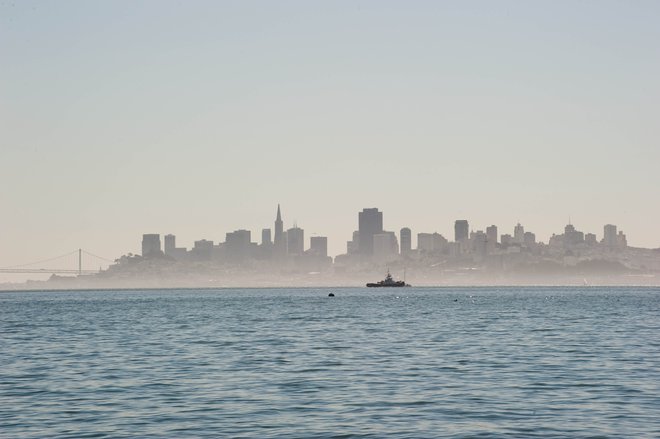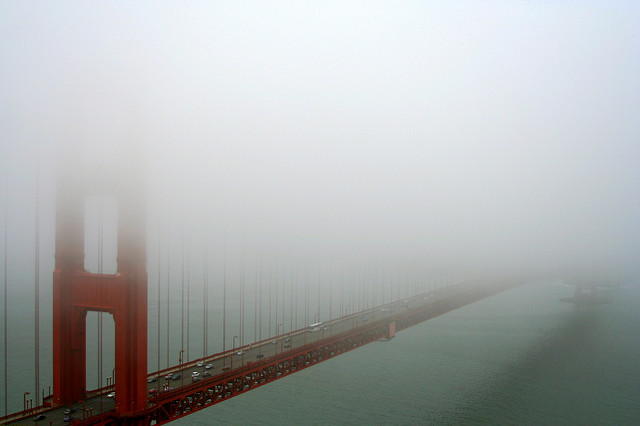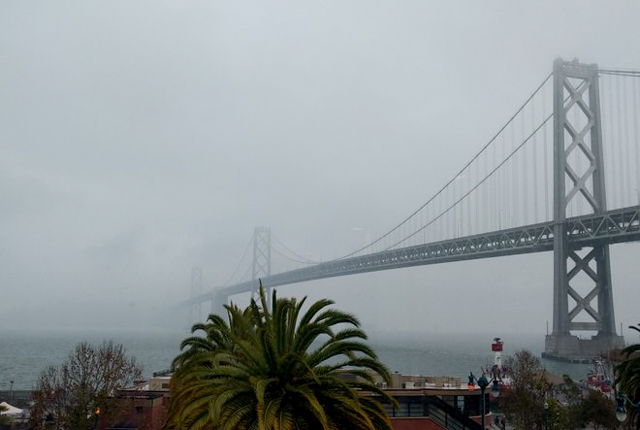
Your visions of a California vacation probably include endless sun, warm weather, and the top down on a convertible rounding the curves of Highway 1. If you’re heading to San Francisco, well… not so fast.
Here's the first thing you should know about traveling to San Francisco: It's often cold. In the summer.
There have no doubt been many a tourist to the City by the Bay to be greeted by cool weather, clouds, and fog, only to think: "This is not the California weather I expected."
The city’s weather has earned it the nickname “Fog City.” It's even part of the reason why the Golden Gate Bridge is famously painted in a bright orange color -- it allows the bridge to be seen by boats through the dense fog. And it's also several degrees cooler in San Francisco than in other parts of sun-drenched California. So, why is it so foggy and chilly in San Francisco?
This is all due to a weather pattern known as the marine layer. (Which is also the name of a cool local clothing shop in Hayes Valley.) Here’s how it works: When the hot, dry inland valleys of central California heat up in the summer, the cold air from over the Pacific Ocean is pulled inland, and the marine layer clouds form along the coast. And since San Francisco is on the bay, the cold air and fog tend to linger over the city. The good news is that despite the fog and clouds, the temperatures in San Francisco are mild year round and the summers see very little rain.
It’s often thought that Mark Twain once said “The coldest winter I ever spent was a summer in San Francisco.” It turns out he didn't say that at all, but the sentiment is clear. Be ready for unexpected weather when you visit this charming California city. To help you prep for your trip, here are six tips on how to deal with San Francisco’s ever-changing weather.
1. Always bring a jacket or hoodie — locals always do.
If there’s only one thing you remember from this article, let it be this. Dress in layers and always bring a jacket. There’s a reason why hoodie sweatshirts are so popular in San Francisco — they’re not only practical, but they also fit the city’s casual atmosphere. Leave an extra layer in your car (even in the summer), especially if you’re heading toward the coast. If you’re traveling on foot or by public transit, grab a tote bag or backpack to bring your layers along. City dwellers generally don’t leave home without them, especially in the evening. (I’ve even been known to throw a pair of leggings into my bag when wearing a dress with bare legs — just in case.)
You may enjoy sun in the middle of the day, so be ready to take those extra layers off, but you’ll be happy you have them if you stay out into the late afternoon. And no, it’s not cold every single day in the city, but it’s good to be prepared!
2. Know that the weather changes by neighborhood.
Golden Gate Park, San Francisco/Oyster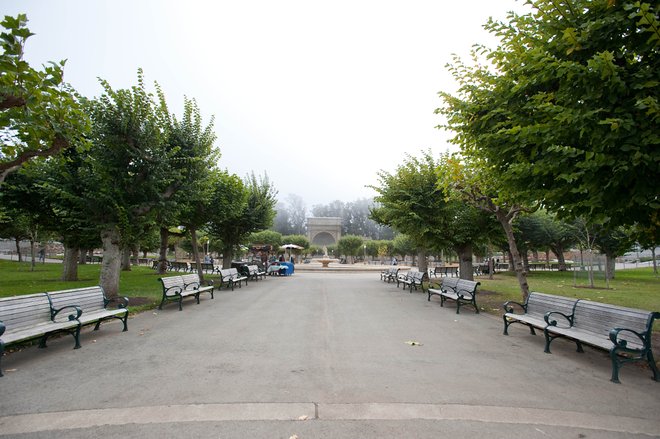
San Francisco has what’s known as “microclimates.” That’s just a fancy way of saying that the weather is different from neighborhood to neighborhood. The unique geography of the city, which is surrounded on three sides by water and has an abundance of hills with different elevations, creates distinct pockets of weather.
In general, the closer you get to the ocean, the cooler and windier it will be. For example, neighborhoods near the coast like the Presidio, the Outer Richmond, and the Sunset, have cooler temps and more clouds. Neighborhoods that are situated further inland are warmer and get more sun, including the Mission District, Potrero Hill, and SoMa.
3. Take the weather forecasts with a grain of salt.
Fort Point, San Francisco/Oyster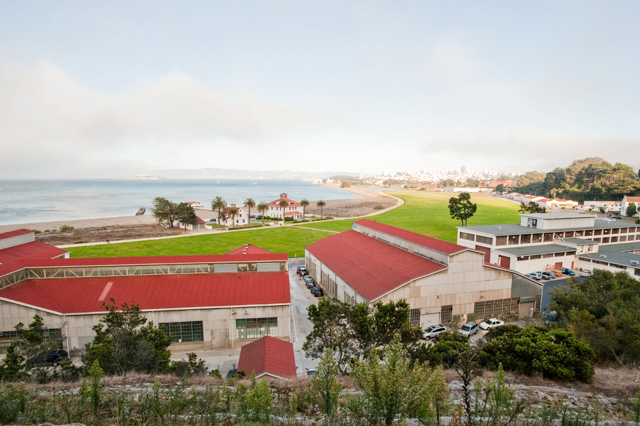
As a San Francisco resident, I look at online forecasts to get a ballpark idea of the weather, but I keep in mind that the temperature and conditions can vary throughout the city. The national forecasts are often wrong. There are a few apps, such as SF Climates and Mr. Chilly, that try to give weather forecasts by neighborhood, which might be more accurate. The best way to know the weather is to take a quick step outside or stick your hand out the window to gauge the temperature. And, of course, bring layers in case it changes later.
4. Know that weather can change drastically depending on the time of day.
Chrissy Field, San Francisco/Oyster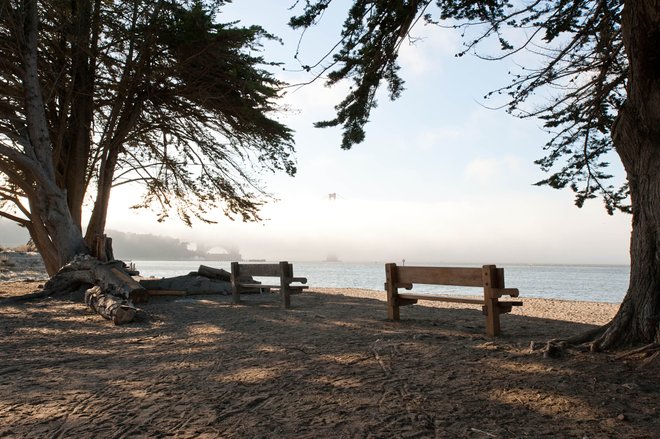
Meet “Karl the Fog.” This is how locals endearingly refer to the blanket of clouds that glide into the city many afternoons. Some say that you could set your watch to it. So, even if you step outdoors in the morning and it’s sunny and hot, there’s no guarantee it’s going to stay that way.
If you know your plans for the day, it can help you determine what to bring. The warmest part of the day is usually from mid-morning to mid-afternoon, with sunny skies during the middle of the day. If you are just going out during this time, and you’ll be back at your hotel before the clouds roll in (generally around 4 p.m.), then you’ll be fine in warm-weather garb.
But if you’re planning to go straight to dinner or an evening event, bring that jacket with you. Also, if you have outdoor plans, like a picnic at the beach or in a park, make your plans so that you take advantage of the warm part of the day, when the sun is shining.
5. To find sun and warmer temps, just head north, south, or east.
Sausalito, San Francisco/Oyster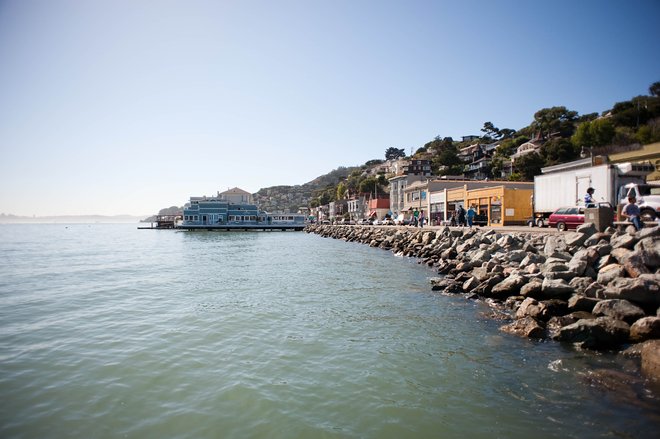
We hope this information didn’t scare you too much about the foggy and chilly San Francisco weather. It’s still a fantastic place to travel any time of year. If it’s cloudy in the city and you’re looking to soak up some sun, that’s no problem. Explore a little outside the city in any direction, and sun is to be found.
Marin County to the north offers beautiful hikes, stunning vistas, and the must-visit Redwood forests, all less than an hour from the city. Head northeast for world-class wine tasting and great farm-to-table restaurants in Napa and Sonoma. Drive south to Santa Cruz or anywhere around Silicon Valley, where sun is plentiful and temperatures are usually higher than in the city. You can travel just over the bay to the east and explore Oakland and Berkeley, too.
6. Enjoy a late summer in the city.
The months of May to August, which are the height of tourist season, can bring cloudy skies and fog to the city. And while the period known as “June Gloom” is familiar to locals all along the California coast, in San Francisco the gloom often extends through “Fogust.”
San Francisco enjoys an extended summer, and often the warmest weather of the year happens in the fall, making it an excellent fall travel destination. September and October can often bring the warm, sunny weather that city dwellers look forward to all year. Plus, this season sees less tourists throughout the city, which means it is the perfect time to check out the area.
You’ll Also Like:
- The 7 Best Beaches in San Francisco
- 10 Outdoor Attractions You Can’t Miss in San Francisco
- 10 of the Best Things to Do in San Francisco
All products are independently selected by our writers and editors. If you buy something through our links, Oyster may earn an affiliate commission.
